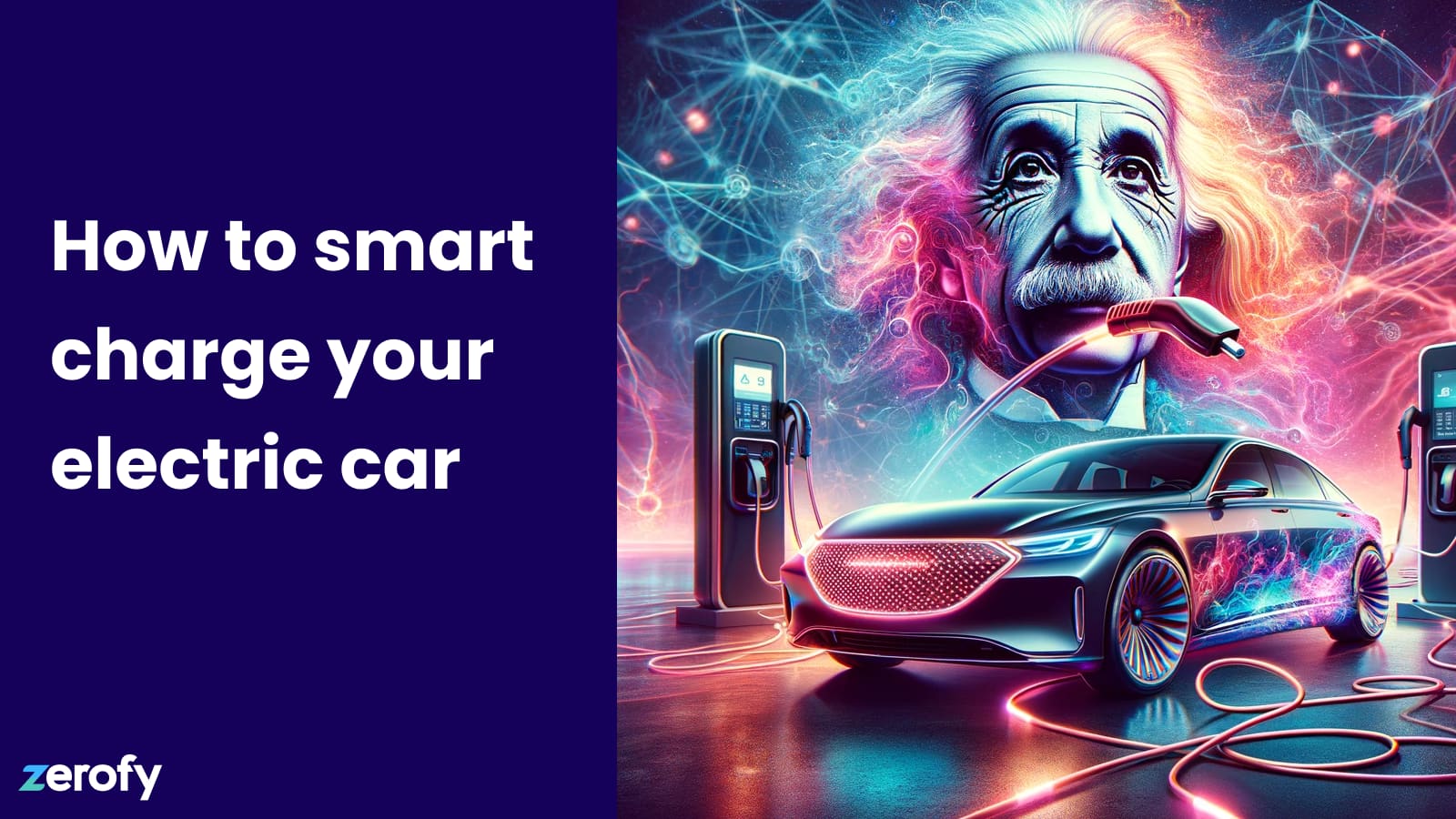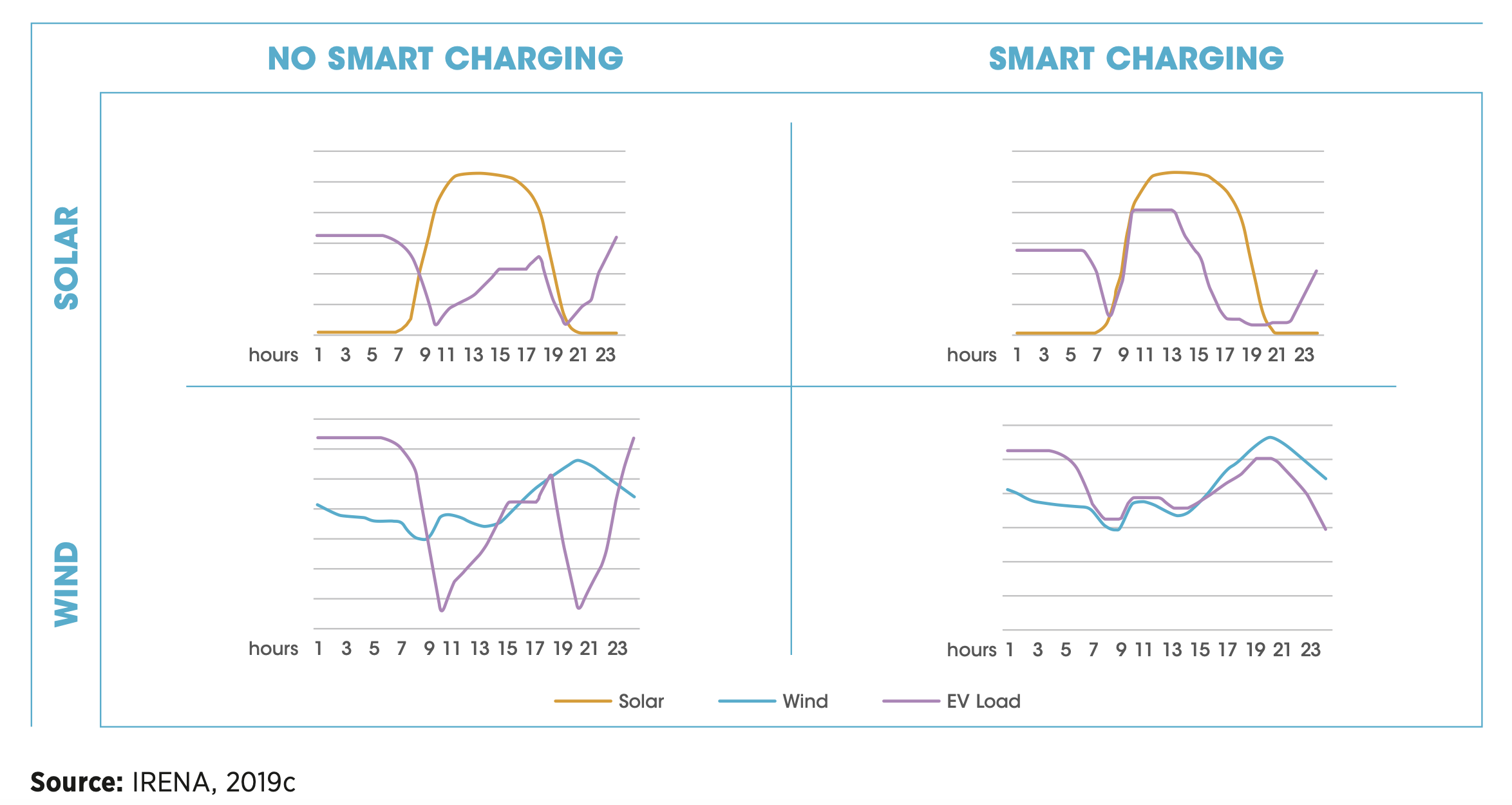How to smart charge your electric car

One of the biggest advantages of electric cars over fossil cars is that they can be simply charged at home or work instead of going to the gas station. Especially if the car is mostly used for commutes, errands, or to drive kids to soccer practice, these types of AC (Alternating Current) charging will be the most common. The typical assumed user behavior is to plug-in the car daily or a few times a week at home, maybe after returning home from work, and let it charge. But given that the car is parked for a long time next to the charger, different charging patterns than the default immediate topup can have various benefits. This is what smart charging is about. This post intends to provide a simple guide to smart charging theory and practice.
What is smart charging?
The term smart charging is used in a variety of ways, but if we were to generalize it one could say that it means charging the car in a different way than the default immediate top up after plug-in, in order to achieve an objective. These objectives can include:
- Reducing charging costs. This may mean simply charging only at night with day/night tariff (admittedly not very sophisticated), or charging at the cheapest rates of a dynamic tariff.
- Minimizing CO2 emissions. The car charges when CO2 intensity of grid electricity is low, i.e. when wind parks or solar parks connected to the grid run at peak loads.
- Minimizing grid strain. Charge at time when the load on the grid is lower. (A dynamic electricity price may already be a signal for demand and grid load - but operators are also experimenting with dynamic tariffs which reflect the grid load directly.)
- Enabling grid flexibility services. There are new services called DR (demand-side response), VPP (virtual power plants), etc. which essentially help to stabilize the grid.
- Increasing self-consumption of rooftop solar. The goal here is to use the electricity within the house, which increases energy independence, but it of course also has benefits for cost, CO2, and grid strain.
From a systems perspective, smart charging cars will be an integral part of the future energy system, and it complements the fluctuating nature of the renewable production very well, as can be seen in IRENA’s chart below:
 The y-axis shows the production of solar and wind over a day, as well as the consumption by an EV fleet with and without smart charging. The goal is to get the consumption and production curves aligned as closely as possible.
The y-axis shows the production of solar and wind over a day, as well as the consumption by an EV fleet with and without smart charging. The goal is to get the consumption and production curves aligned as closely as possible.
Of course, for the individual household the main benefit of smart charging will often be cost saving, but if done well, the household and system-level perspective don’t contradict each other.
Options for smart charging
But how do you smart-charge your car in practice? You have a number of options.
Your EV itself and its companion app
Most electric cars and their apps offer some simple smart charging capabilities, such as scheduling for night time charging. The big advantage of the car and car app is that they have a lot of information about the car, including the current state of charge (Soc) and the target SoC. This information would allow for planning charging sessions, however in practice most car apps are rather limited when it comes to smart charging.
EV charger hardware and app
Your EV charger wallbox is an obvious starting point for smart charging. Often the system is already prepared for load balancing with several chargers in the same installation, if applicable. Modern chargers like Easee, Wallbox, or Zaptec come with a companion app, which allows to control the charging remotely, and may offer additional features. Charger manufacturers are also extending their offering with hardware modules that allow for solar-excess charging, by measuring current solar production and home consumption via hardware interfaces. These hardware come at extra cost. Also, to our knowledge, dynamic tariffs are not integrated with the common chargers.
One very important factor to understand is that (maybe counterintuitively) AC chargers don’t know the state of charge of your car. That means that the charger does have no information about how much it needs to charge until the car is full. It just gets a response from the car once it’s full, but it can’t “plan” the duration of a charging session ahead of time. The charger however can often nicely regulate the charging power and/or switch between one and three phase charging, to control how fast it is charged. This is useful for excess solar charging to just draw the amount of charging power that matches the current solar excess power. Or it is useful to load balance or avoid blowing the fuse when other big consumers are running in a house with limited fuse size.
Dedicated smart charging apps
There are a variety of apps (Jedlix, Optiwatt, Gridio, …) that allow smart charging of your EV, which usually means charging it at the lowest electricity price. Some apps (like Monta) allow setting a preference between low price and low co2 intensity. These apps usually connect to your EV via the car vendor’s cloud platform API. You log in with your EV account credentials, and then give access to your EV.
The app gets the electricity prices for the next day, and using the current state of charge and desired state of charge calculates the amount to charge. It then schedules the required number of hours of charging at the cheapest hours.
The way the app interacts with the car via the API requires that it constantly checks the state of the car. Once the car is plugged in, it will start charging. As soon as the app notices that a car is plugged in and charging, it will stop/pause the session until the calculated time window for charging comes up, when it will resume charging. Here a good user interface and communication of status by the app is essential: if the car stops charging after a few minutes after plugging in, and the user is not aware that this is due to a smart charging app they may have installed, they may think something is wrong with the car.
Some of the apps also connect with your charger, which allows steering the sessions via the charger and not only via the car (but without access to state of charge), and some also offer connectivity to solar inverters for solar excess charging. But overall the focus is connecting to your EV and charging at the lowest price from the grid.
One important thing to keep in mind is that your car will need cell phone connectivity to wake up and be controlled from the app. If your car is e.g. parked in an underground garage, it may not have connectivity and cannot be reached to control smart charging from the charging app. Wifi connectivity is not enough, when your car goes to sleep. Typically the car can only be woken up via a cell (GSM) signal. However, note that as soon as your wallbox charger initiates charging, it also wakes up the plugged-in car. This means that in the case of an underground parking garage, smart charging via the wallbox charger may be your only option. The disadvantage in that case is that the state-of-charge of the vehicle is not known. (The ideal setup would then be a system that can combine the charger and EV information, when both are connected.)
Your energy provider’s app with smart charging
An increasing number of energy providers offer smart charging as part of their customer apps. “Neo”-energy providers like Tibber were the pioneers in this area, but increasingly traditional providers come to market with similar offerings. The smart charging functionality or app is often a whitelabel product from some of the common B2C vendors.
Energy providers have the advantage of coupling the smart charging functionality with their tariffs, and they can give specific tariffs or discounts to EV drivers who connect their vehicle and let it be smart charged by the energy provider. The energy/grid provider can benefit from this by offering capacity on so-called flexibility markets, optimize their short term energy purchases, or just ensure grid stability. The monetary returns from these activities are then often shared with the user or already “baked-in” with the dedicated tariff offered to the user.
Home energy management systems and apps
Smart charging is also a part of home energy management systems (HEMS), in particular those that target electrified households with solar, heat pump, EV, etc.
The big advantage of a HEMS is that it has the full context of all energy consumption and solar yield in the home, whereas the previous solutions have a limited “view”. Having all the information allows for making the best optimisation decisions: when and in what order to turn on which devices for example. So Smart Charging your EV can be treated as one of the functions of home energy management overall.
Many HEMS originated from the solar-self consumption optimization use case, and hence they are often very focussed at that (with or without a local battery). Only recently some of the systems have also started integration of dynamic electricity tariffs, which allows for reducing grid consumption costs further.
Another characteristic of traditional HEMS is that they require local hardware and are often complex to set up and configure through dashboards with lots of settings. Local hardware and fixed wiring has some benefits with additional reliability. In the case of EV smart charging however, they can only steer through the charger, unless they add cloud APIs also into their system.
Some more recent HEMS (like our own Zerofy) are purely cloud based, without local hardware. Think of a smart charging app on steroids, or a next-gen HEMS. These systems rely purely on cloud accounts of various hardware (solar inverter, heat pump, charger/EV, etc.) which makes them simple and cost effective (you can save from 500 up to even more than 1000 Euro upfront costs!) to set up. There is no additional hardware that needs to be installed - all users need to do is to connect with the different services via their cloud accounts.
How to smart-charge your car: choosing the option that’s right for you
What option is the right one for you depends on your setup and your habits:
- Do you just have an EV and charge mainly from the grid? Or do you have a home with solar, heat pump, and more? In the former case a simple smart charging app may do it, in the latter we’d recommend a HEMS product.
- Do you have a dynamic tariff to really benefit the most from smart charging?
- Do you have your own charger that you can plug in your car every day? Or do you share a charger with other tenants of a building?
- Do you park in a place where you have connectivity for your car, or for example in an underground garage? In the latter case you’d need to be able to control charging via the charger and not the EV.
Finally, to truly benefit from smart charging, it’s also good to develop a habit of having your car plugged in most of the time when it is parked.
This concludes our overview of smart-charging options. And if you want to try smart charging and home energy management right away, maybe you’d like to give Zerofy a shot. All you need to do is to get the app and connect your EVs and devices in the app.